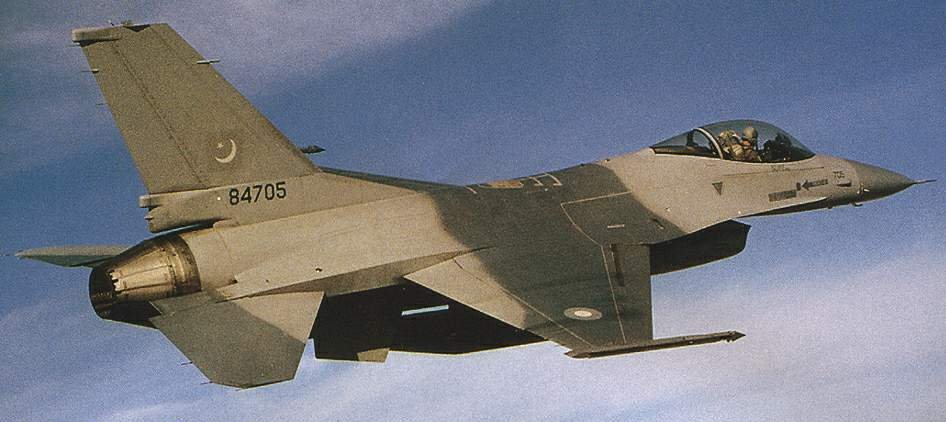
US-Pak F-16 Diplomacy : Concerns Galore

The Biden administration approved the $450 million package for Pakistan’s fighter jets’ related equipment and the F-16 fleet sustainment programme. The Pentagon’s Defence Security Cooperation Agency has confirmed that no new capabilities, weapons, or munitions are included in the sale. The proposed equipment and support package will not change the regional primary military balance. They also asserted that it would aid Pakistan in fending off potential threats from terrorism in the future.
In a significant move, the US offered the F-16 fleet sustainment package, i.e., ‘air-shield’ aid to flood-affected Pakistan. The US’s action may be addressing multiple geopolitical developments of the region. Their major concerns are – ‘Strengthening of China-Pakistan relationship’, ‘Removal of Pakistan from FATF grey list’, ‘Pakistan leaning towards Russia’.
The F-16 upgrade will include modifications to the aircraft’s hardware, software, support, and electronic warfare capability, the engine, the overall structure, the fighter and engine spare repair/return parts, and the engine. Additionally, it included engineering, technical, and logistical services as well as lab equipment, precision measurement, calibration, and technical support services from the US Government and contractors.
This US action raises interesting questions in light of FATF’s actions against Pakistan. Donald Lu and other top US officials were in India for a US-India 2+2 Intersessional Meeting and Maritime Security Dialogue when the package was approved. Donald Lu, the US Assistant Secretary of State for South and Central Asian Affairs, has come under fire from New Delhi for the timing and actual terms of the deal.
The PAF F-16 remains the most modern and effective aircraft in Pakistan’s fleet despite the country’s heavy reliance on Chinese-made jets. According to a report in The Financial Times, Pakistan “threatened to buy Chinese or Russian fighter planes if American lawmakers continued to deny funding for Islamabad’s purchase of eight F-16 Block-52 jets made in the United States.”
Pakistan said it would consider purchasing Chinese-built J-10 and J-20 multi-role fighters and Russian Sukhoi SU-35 multi-role fighters. Alternatively, the PAF may spend its money on more Chinese JF-17s than brand-new Chinese or Russian fighter planes. The US is paying close attention to how the relations between China and Pakistan are developing. This agreement could be a step toward preserving the US-Pakistan relationship.
F-16: A Versatile Platform
The F-16 was built to be aerodynamically unstable until it reached supersonic airspeeds, unlike any other aircraft ever constructed. Initially, the F-16 was not a multi-role aircraft. Nevertheless, it was the first multilateral fighter plane intended to replace outdated fighters like the F-5 Freedom Fighter and the F-104 Starfighter. The fighter was created by Belgium, Denmark, the Netherlands, and Norway. It was designed to be a quick, light day fighter.
However, the F-16 is still far superior to many other fighters due to the following characteristics of the aircraft:
(a) Fly-by-Wire flight controls and side-stick controller: This provides the interface necessary for the onboard computer to interpret pilot inputs and move the flight controls accordingly.
(b) Frameless bubble canopy: As “lost sight means lost fight” in the combat (dogfighting) ring, the frameless bubble canopy gives pilots an advantage.
(c) Multi-Function Displays: Instead of the conventional “steam gauges,” the aircraft has a “glass” cockpit that enables the pilot to customise his displays for both a particular mission and personal preference.
(d) Reclined Ejection Seat: Offers superior G tolerance and lessens the pilot’s exposure to g-forces.
(e) Elements that contribute to the aircraft’s value-addition include:
(i) Portability
(ii) Increased nimbleness
(iii) Cost-effectiveness
(iv) Better accelerating
(v) Manoeuvrability
PAF’s F-16s
Pakistan and the US worked together to organise and arm mujahedeen in refugee camps for Afghans in Pakistan after the Soviet Union invaded Afghanistan in 1979. In retaliation, Soviet and Afghan planes bombed the camps, but the PAF’s Chinese-made J-6 jets were too slow to intercept them. As a result, Pakistan persuaded the US to offer its F-16 Fighting Falcon single-engine multi-role fighter in 1981. This fighter was a state-of-the-art yet affordable design with a fly-by-wire control system that enabled remarkable manoeuvrability. However, early F-16 production models lacked the ability to fire beyond-visual-range (BVR) missiles. Its combat range was constrained (around 350 miles).
The US halted sales of several F-16s when the Pressler Amendment’s punitive measures against nuclear proliferation took effect in 1990.
This was used by Pakistanis as evidence of American betrayal and as proof that Washington is an unreliable ally.
However, despite providing service for over 30 years, some problems remain unresolved for a number of reasons. The General Dynamics/Lockheed Martin F-16 “Fighting Falcon” has been operated by Pakistan with three main problems:
(a) Incompatibility with locally produced Datalink. F-16 uses Link-16, while Pakistani Datalink uses Link-17.
(b) Lack of AAR capability prevents F-16s from using PAF’s Russian Il-78MP tankers for mid-air refuelling.
(c) Strict regulations for weapon upgrades, modifications, and integration: The original equipment manufacturer must approve any new armament, integration, or airframe upgrades.
Implications on Regional Geopolitics
India has voiced concern over the United States’ choice to support Pakistan’s F-16 fighter aircraft fleet with a maintenance package. The combat abilities of the PAF would be improved by upgrading the F-16s. The most potent fighter jets in Pakistan’s arsenal are the 76 F-16s supplied by the United States to its armed forces.
Following his telephone conversation with US Secretary of Defence Lloyd Austin, Indian Defence Minister Rajnath Singh posted on Twitter, “I conveyed India’s concern at the recent US decision to provide a sustenance package for Pakistan’s F-16 fleet.” The “growing convergence of strategic interests and enhanced defence and security co-operation” was the topic of Raksha Mantri’s speech, according to him.
The US and the West do not approve of India’s stance on economic sanctions against Russia, absence from voting against Russia at the UN, and uninterrupted access to crude oil to meet its needs. Few critics interpreted the F-16 package to Pakistan as an American response to Indian posturing. Days after Indian Defence Minister Rajnath Singh expressed India’s concern to his US counterpart Lloyd Austin over the supply of F-16s to Pakistan, the US stated on September 29, 2022, that “it is not designed as a message” to New Delhi for taking a neutral stance toward Russia in the ongoing conflict in Ukraine.
F-16 aircraft were used by Pakistan in an air battle against India in 2019, but not against terrorism. The F-16 mission was over Pakistan-occupied Kashmir, which Pakistan regards as a disputed area. This incident makes it clear that Pakistan intends to use F-16s for commercial purposes.
Politicians in the US have grown increasingly critical of Pakistan’s policies in recent years, charging Islamabad with working against their interests and providing a safe haven for the Taliban while still receiving tens of billions of dollars in military aid.
A top American diplomat reprimanded Pakistani Air Force Chiefs of the time period, according to documents obtained by US News, for misusing F-16 fighter jets provided by the US and endangering their shared security. A few months prior to the communication, India claimed to have shot down one of these F-16s. In the letter, national security adviser to Vice President Mike Pence Thompson chastised Pakistan for “relocating, maintaining, and operating American-made F-16 fighter jets and AMRAAM from forward operating bases that were not mandated under the original terms of the sale.” The assertion that these aircraft are employed in the fight against terrorism begs the question of how a country that functions as a hub for terrorism can initiate counterterrorism operations.
Osama bin Laden was only given a secure home by Pakistan, the Taliban were given safe havens, and Pakistan actively supported terrorism against both Indian and US forces in Afghanistan through the Taliban. As a result of Islamabad’s connections to the Haqqani network, a militant organisation known for attacking US-trained security forces in neighbouring Afghanistan, Republican Senator Bob Corker opposed using taxpayer money to subsidise Pakistan’s F-16s earlier this year.
Without US access to Pakistani airspace, the recent drone attack in Kabul on Al-Qaeda leader Ayman al-Zawahiri would not have been possible, which explains Secretary of State Antony Blinken’s dedication to “expanding the US-Pakistan partnership.” It might serve as this mission’s prize.
Since the end of the Cold War, Pakistan has lost its geopolitical importance for monitoring Chinese and Russian nuclear and missile development. Geographically speaking, China is now Russia’s distant neighbour and Pakistan’s closest ally. In the past, Pakistan was helpful in this regard, but not anymore. Regarding the F-16 package to Pakistan, Dr. S. Jaishankar, Minister of External Affairs, has also stated that “Very honestly, it’s a relationship that hasn’t ended up serving Pakistan well, nor the American interests.” Therefore, the United States should really consider the benefits of this relationship and what they gain from it today.
In the early 1980s, the US agreed to sell Pakistan F-16 fighter jets. When the US and Pakistan collaborated closely to drive the Soviets out of Afghanistan, this choice was made. The most important air platform for Pakistan and the most likely platform to deliver a nuclear weapon was the F-16.
A significant development is the US administration’s announcement that it will give Pakistan $450 million in defence equipment for its F-16 fighter jet fleet. This will improve the F-16 fighter jets’ ability to carry out missions. The EW suite will see a significant improvement, enabling safe penetration of any airspace.
Additionally enhancing the credibility of the aircraft operations are structural and engine spares. Overall, the PAF’s F-16 fleet will have significantly better maintenance rates.
PAF F-16s eventually became a crucial link between Pakistan and the US. The maintenance of the Pakistan-US relationship also depended on this link. The F-16 was used by the US as a diplomatic tool to deal with Pakistan in accordance with their needs as determined by regional geopolitics.
**************
Disclaimer
The opinions expressed in this article are the author’s own and do not reflect the views of Chanakya Forum. All information provided in this article including timeliness, completeness, accuracy, suitability or validity of information referenced therein, is the sole responsibility of the author. www.chanakyaforum.com does not assume any responsibility for the same.
Chanakya Forum is now on . Click here to join our channel (@ChanakyaForum) and stay updated with the latest headlines and articles.
Important
We work round the clock to bring you the finest articles and updates from around the world. There is a team that works tirelessly to ensure that you have a seamless reading experience. But all this costs money. Please support us so that we keep doing what we do best. Happy Reading
Support Us





















POST COMMENTS (1)
Kalidan Singh